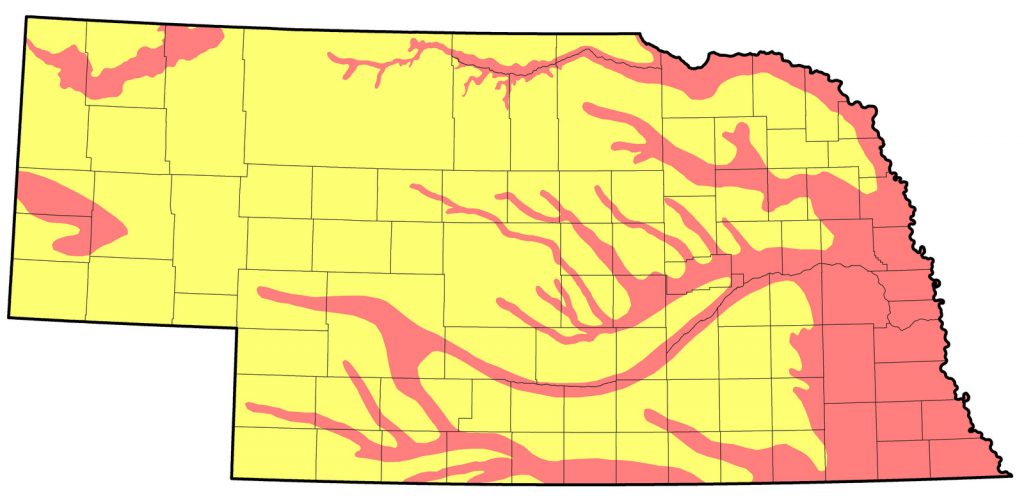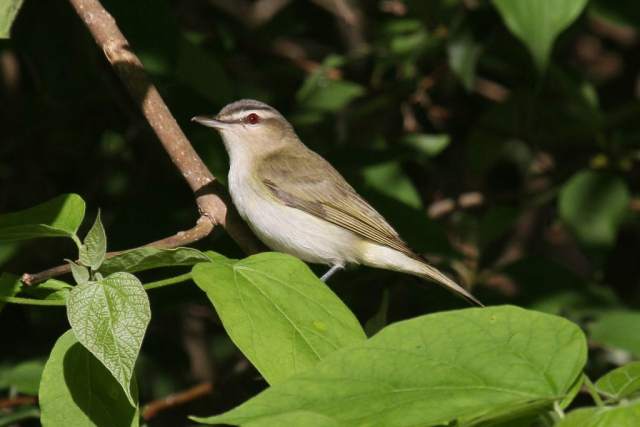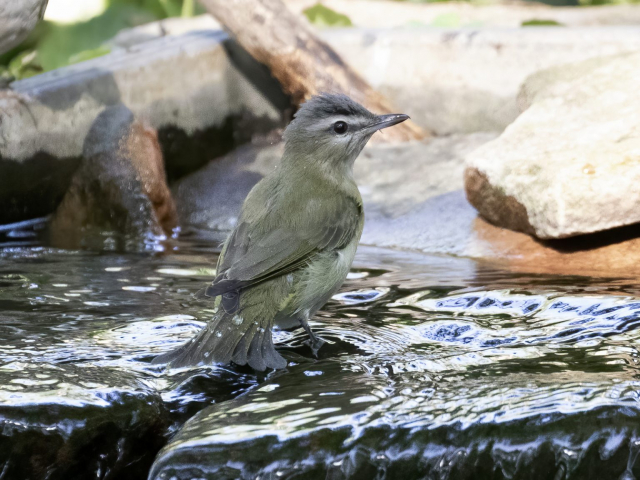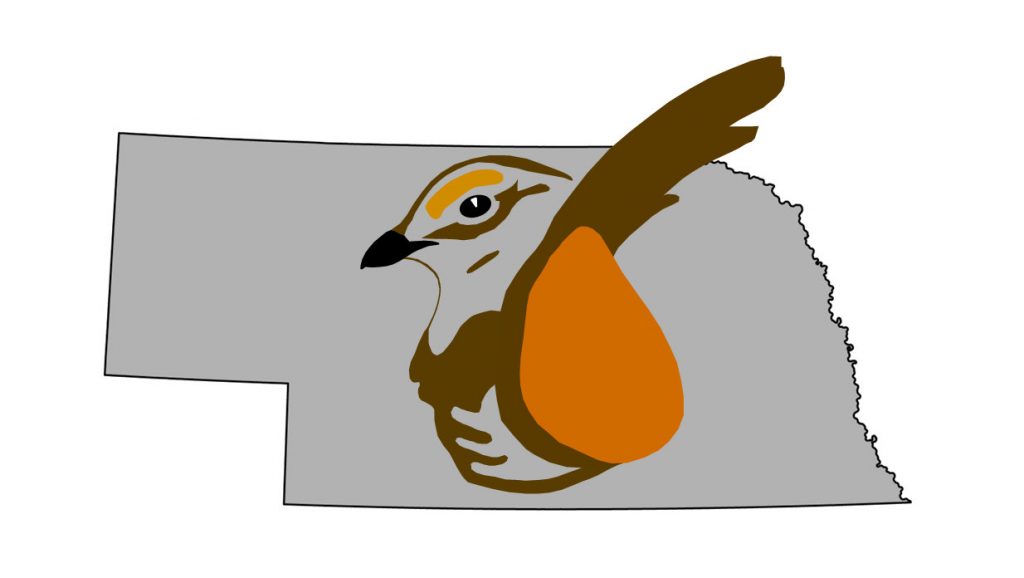Vireo olivaceus olivaceus
Status: Common regular spring and fall migrant east and central, uncommon west. Common regular breeder east, locally common elsewhere.

Documentation: Specimen: UNSM ZM6782, 22 May 1900 Monroe Canyon, Sioux Co.
Taxonomy: The allocation of nine Central and South American subspecies (Chesser et al 2018) to a newly erected species Chivi Vireo (V. chivi) leaves Red-eyed Vireo (V. olivaceus) of Canada and east central and eastern USA monotypic.
Nebraska birds are olivaceus.
Spring: Apr 26, 26, 27 <<<>>> summer
Earlier dates are 23 Apr 2012 Lancaster Co, and 24 Apr 2025 Douglas Co.
Migrants arrive in late Apr, with peak numbers in mid-May.
- High counts: 49 at Indian Cave SP, Nemaha and Richardson Cos 12 May 2000, and 48 there 12 May 2004.
Summer: BBS data indicate that the species breeds across the state; reports are fewest in the southwest, southern Panhandle (away from the North Platte River Valley), and Sandhills. Red-eyed Vireo prefers deciduous forest, and, while it breeds on the pine-covered Pine Ridge and Wildcat Hills (Mollhoff 2001), it is limited to riparian habitats there in canyons and along river valleys (Rosche 1982). BBS trend analysis (Sauer et al 2020) show Red-eyed Vireo abundance has increased 2.11% (95% C.I.; 0.83, 3.29) annually statewide 1966-2019.
Numbers may have increased in the southwest, as prior to 2000 there were very few reports there, including only three breeding season records south of the Platte River and west of Grand Island, Hall Co in the first BBA period 1984-1989 (Mollhoff 2001). In addition to those three records, a singing male was in Hitchcock Co 9 Jun 1990 (Grzybowski 1990), and two were in Dundy Co 22 Jun 1994. However, since 2000 eBird data show numerous post-2000 breeding season (Jun-Jul) reports for the area south of the Platte River Valley and west of Lexington, Dawson Co and 14 were at Medicine Creek Reservoir, Frontier Co, 30 Jun 2002. Furthermore, Mollhoff (2016) showed widespread reports in this region and stated it is “rapidly expanding its range along our rivers as woodlands mature”.
The only Jun-Jul record in Kimball, Cheyenne, or Deuel Cos in the southern Panhandle is of singles at Oliver Reservoir, Kimball Co 1 and 4 Jun 2019, probably migrants.
In the western Sandhills, there are numerous breeding season reports in the area southwest of Valentine in the Snake River drainage, Cherry Co and at NNF Bessey, Thomas Co. However, the only breeding season reports in the western Sandhills away from these two areas are 11 Jun 2022 Grant Co, 18 Jun 2012 near Elsmere, southeast Cherry Co, 25 Jun 2023 Arthur Co, and 30 Jun 2007 central Cherry Co. There are three reports from Crescent Lake NWR, Garden Co, all probably migrants: 1 Jun 2013, 3 Jun 2010, and 4 Jun 2007. There are only two records for the stretch of the Niobrara River Valley from south of Cody, Cherry Co and Chadron, Dawes Co: 18 Jul 2019 Lyons Bridge, Cherry Co, and 20 Jul 2019 131st Trail crossing, Sheridan Co (eBird.org, accessed Nov 2023).
-
- Breeding Phenology:
- Eggs: 23 May- 6 Jul (Mollhoff 2022)
- Nestlings: 30 May-30 Jun
- Fledglings:14 Jul-11 Aug
- High counts: 28 at Fort Falls, Niobrara NWR, Cherry Co 7 Jun 2022, 25 at Gilbert-Baker WMA, Sioux Co 9 Jun 2023, 24 in Howard Co 8 Jun 2004, 24 at Anderson Bridge WMA, Cherry Co 8 Jun 2022, and 24 at Branched Oak Lake, Lancaster Co 9 Jun 2023.
- Most of these counts may include migrants.
Fall: summer <<<>>> Oct 5, 7, 7
Later dates are 9 Oct 2022 Harlan Co, 7-12 Oct 2024 Sarpy Co, 12 Oct 2015 Nemaha Co, 17 Oct 2020 Dundy Co, and 23 Oct 2021 Lancaster Co.
Two that appeared at Wind Springs Ranch in southern Sioux Co 28 Jul 2006 may have dispersed from the Pine Ridge in response to extensive fires there.
Peak migration is in early to mid-Sep. Departure generally occurs by late Sep, although there are several Oct reports.
- High counts: 50 in Dakota Co 6 Sep 2014, 30 there both 27 Aug and 5 Sep 2023, 29 in Schuyler, Colfax Co 7 Sep 2014, 20 at Ponca SP, Dixon Co 2 Sep 2018, and 20 at Pawnee Lake SRA, Lancaster Co 9 Sep 2018.
Comments: A Red-eyed Vireo at Wilderness Park, Lancaster Co 12 May 2022 was recorded interspersing single Great Crested Flycatcher “wheep” notes with its usual song (Stearns, eBird.org). This phenomenon has been reported before (Blincoe 1924, James 1976), but would be easy to overlook, assuming a Great Crested Flycatcher was calling in the vicinity.
Images
Abbreviations
-
- BBA: Breeding Bird Atlas
BBS: Breeding Bird Survey
NNF: Nebraska National Forest
NWR: National Wildlife Refuge
SP: State Park
SRA: State Recreation Area
UNSM: University of Nebraska State Museum
- BBA: Breeding Bird Atlas
Literature Cited
Blincoe, B.J. 1924. Red-eyed Vireo mimics the call notes of the Crested Flycatcher. Wilson Bulletin 36: 136.
Chesser, R.T., K.J. Burns, C. Cicero, J.L. Dunn, A.W. Kratter, I.J. Lovette, P.C. Rasmussen, J.V. Remsen, Jr., D.F. Stotz, B.M. Winger, and K. Winker. 2018. Fifty-ninth Supplement to the American Ornithological Society’s Check-list of North American Birds. Auk 135: 798–813. https://doi.org/10.1642/AUK-18-62.1.
Grzybowski, J.A. 1990. Southern Great Plains Region. American Birds 44: 454-457.
James, R.D. 1976. Unusual songs with comments on song learning among vireos. Canadian Journal of Zoology 54: 1223-1226.
Mollhoff, W.J. 2001. The Nebraska Breeding Bird Atlas 1984-1989. Nebraska Ornithologists’ Union Occasional Papers No. 7. Nebraska Game and Parks Commission, Lincoln, Nebraska, USA.
Mollhoff, W.J. 2016. The Second Nebraska Breeding Bird Atlas. Bull. Univ. Nebraska State Museum Vol 29. University of Nebraska State Museum, Lincoln, Nebraska, USA.
Mollhoff, W.J. 2022. Nest records of Nebraska birds. Nebraska Ornithologists’ Union Occasional Paper Number 9.
Rosche, R.C. 1982. Birds of northwestern Nebraska and southwestern South Dakota, an annotated checklist. Cottonwood Press, Crawford, Nebraska, USA.
Sauer, J.R., W.A. Link, and J.E. Hines. 2020. The North American Breeding Bird Survey, Analysis Results 1966 – 2019: U.S. Geological Survey data release. https://doi.org/10.5066/P96A7675.
Recommended Citation
Silcock, W.R., and J.G. Jorgensen. 2025. Red-eyed Vireo (Vireo olivaceus). In Birds of Nebraska — Online. www.BirdsofNebraska.org
Birds of Nebraska – Online
Updated 12 Jun 2025


